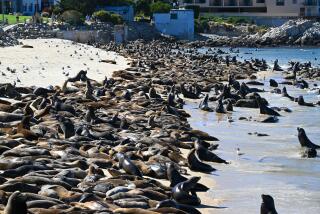Hunters Killing Island’s Wild Pigs : Ecology: Thinning the numbers of swine on Santa Cruz will protect habitat, the park service says.
- Share via
Stalking through thick brush and steep canyons, high-powered rifles in tow, hunters are methodically tracking wild pigs on Santa Cruz Island and shooting them dead.
*
Federal biologists have killed at least 170 of the unwelcome intruders within the past two weeks, lowering by 5% the population of rummaging swine. They also killed a 15-year-old horse by mistake.
National Park Service officials say the periodic hunts are needed to maintain the native plants and animals, which are systematically ravaged by the wild pigs.
“Right now, the population on Santa Cruz is extremely high,” said Kate Faulkner, the park’s director of management resources. “Basically, we’re trying to do a control operation to limit the damage.”
But some animal rights supporters are complaining because hunters have left the corpses rotting in the sun. In addition, they say, there are other ways to deal with the bothersome pigs, such as neutering or relocating the animals.
“They’re spraying bullets out there. It’s a kind of thrill killing,” said Ted Green, a Ventura resident who installed communications lines on Santa Cruz Island for more than 40 years. “They’re not even harvesting the meat.”
The two hunts this month are not the first. The National Park Service in 1991 hired professional hunters to kill off the wild pig population on nearby Santa Rosa Island, a $310,000 effort that was largely successful.
“That is what needs to happen on Santa Cruz,” Faulkner said. “The best way to deal with the situation is to go in and over a short term--a year or two--hit them hard, hit them fast and eliminate the entire population.”
But that’s not going to happen.
*
Officials of the Nature Conservancy of California, a private agency that owns 90% of Santa Cruz Island, say they have no plans to kill all of the 4,000 or so wild pigs scouring the 96-square-mile island.
Instead, they hope to regulate the population as best they can with their limited resources.
“We have hunting focused on maintaining a research area free of pigs,” said Lynn Lozier, the conservancy’s coastal area director. “It’s a really important source of information for us.”
Lozier said the Nature Conservancy and the National Park Service also sporadically weed out the 100-pound pigs from around other vital areas of the island, including the airstrips and certain fields of rare plant life.
“We’re not currently involved in any kind of overall eradication effort,” she said.
The pigs were introduced to the Channel Islands by ranchers in the mid-1850s. Since then, the population has fluctuated drastically due to seasonal weather conditions.
By the end of the six-year drought in 1992, fewer than 1,000 pigs inhabited Santa Cruz Island, the largest of the chain. Now, the number has quadrupled.
The animals inflict serious damage on many of the plants and animals that are found nowhere else, biologists say.
“They’re like rototillers,” Faulkner said. “There are whole plant communities that have been extremely damaged by the pigs.”
Lyndal Laughrin, a UC Santa Barbara researcher who has lived on Santa Cruz Island since 1971, said the pig hunts may not be popular. But they are necessary.
“It doesn’t look good and it sounds bad,” said Laughrin, whose wife owned the horse that was accidentally shot. “But unfortunately, nobody’s figured out a better way to do it.”
*
Laughrin said biologists worried about preserving the island for native species have little choice but to shoot the pigs. Plants such as the rock cress and island oak can be found in few other places in the world, he said.
“We’re trying to remove these negative impacts and get back to a natural process,” he said.
Park service officials defended themselves against the charge of letting the pigs’ corpses rot. There are too many difficulties involved with putting the meat to use, they said.
“To meet human consumption standards, you have to process the meat and refrigerate it immediately,” Faulkner said. “There’s no way to transport meat.
“So by the time you were able to bring the meat off the island, to meet health standards, it might be $20 a pound.”
More to Read
Sign up for Essential California
The most important California stories and recommendations in your inbox every morning.
You may occasionally receive promotional content from the Los Angeles Times.













